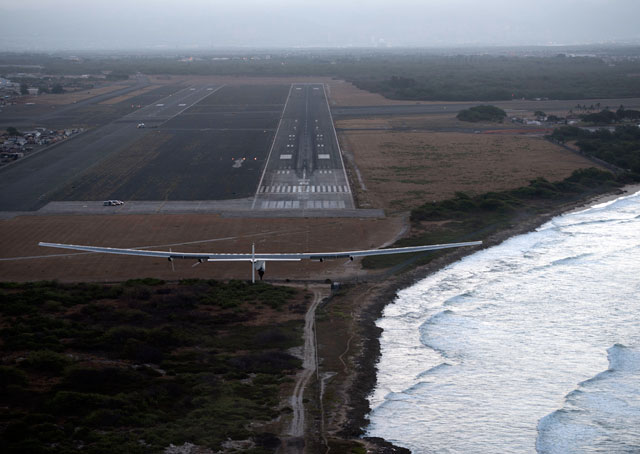Solar Impulse airplane undergoing repairs in Hawaii

Solar Impulse, an airplane powered only by the sun and 2,000 pounds of batteries, has completed the most difficult leg of a round-the-world flight, but will sit grounded in Hawaii for several months to repair damage caused by battery overheating. The Solar Impulse team announced July 15 that the second half of the trip would be delayed until April 2016.
The uncontrolled increase in battery temperature was caused by over-insulation. The problem had the aircraft’s mission team nervously watching as soon as the aircraft began its climb to 28,000 feet at the start of the five-day-and-night flight leg from Nagoya, Japan, to Hawaii, said Solar Impulse founders and pilots Bertrand Piccard and Andre Borschberg on the project website.
"And while the Mission Team was monitoring this very closely during the mission leg, there was no way to decrease the temperature for the remaining duration of the flight as each daily cycle requires an ascend to 28’000 feet and descend for energy management issues," they said.
The overheating caused irreversible damage to some battery components, requiring repairs "that will take several weeks to work through," they said.
During the down time in Honolulu, Solar Impulse’s engineering team also "is looking at various options for better management of the cooling and heating process for very long flights."
The so-called zero-fuel airplane launched from Abu Dhabi on March 9 on "the first ever Round-The-World solar flight." It landed in Hawaii on July 3, having accomplished eight legs and 18,000 miles of its mission "to inspire innovation and pioneering spirit and encourage the adoption of clean technologies, renewable energy and energy efficiency."
The 117-hour, 52-minute flight leg from Nagoya to Hawaii, flown by Borschberg, established a record for oceanic flight in a solar-powered airplane, the team said.
During the timeout for maintenance, "It’s time for thousands of American citizens to discover the round-the-world airplane" in its Honolulu hangar, the flight team said.
After repairs, Solar Impulse will head to the U.S. West Coast.



